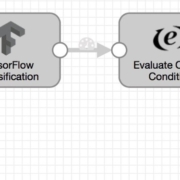The real value of a modern DataOps platform is realized only when business users and applications are able to access raw and aggregated data from a range of sources, and produce data-driven insights in a timely manner. And with Machine Learning (ML), analysts and data scientists can leverage historical data to help make better, data-driven business decisions-offline and in real-time using technologies such as TensorFlow.
In this post, you will learn how to use TensorFlow (TF) models for prediction and classification using the newly released TensorFlow Evaluator* in StreamSets Data Collector 3.5.0 and StreamSets Data Collector Edge.






